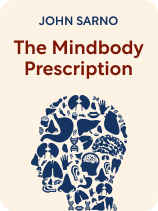

This article is an excerpt from the Shortform book guide to "The Mindbody Prescription" by John Sarno. Shortform has the world's best summaries and analyses of books you should be reading.
Like this article? Sign up for a free trial here.
What are the key takeaways from The Mindbody Prescription? How does author Dr. John Sarno explain the connection between mind and body?
In The Mindbody Prescription, Dr. Sarno explains how repressed emotions can lead to physical feelings of pain, a disorder he calls tension myositis syndrome (TMS). Learning these concepts supports the healing process.
Keep reading to discover how the mind and the body are connected, and how to diagnose and treat TMS.
About The Mindbody Prescription
Do you struggle with ongoing pain that doesn’t seem to respond to treatment? In The Mindbody Prescription, physician and professor of rehabilitation medicine John Sarno explains that the Western world is experiencing an epidemic of disorders characterized by chronic pain with no clear cause. Doctors diagnose and treat these pain disorders as physical problems, but often, their treatments don’t provide any relief. Sarno explains that this is because the problem isn’t physical, it’s emotional—and the key to solving your pain is resolving your emotional tensions.
In this article, we’ll explain the development and principles of Sarno’s theory and discuss what kind of person is most likely to develop these types of disorders. We’ll also explain the different physical ways in which emotional tension manifests, as well as Sarno’s treatment method. We’ll supplement Sarno’s ideas with scientific and social context as well as tips from other experts on dealing with chronic pain.
A Chronic Pain Epidemic
According to Sarno, doctors have been diagnosing patients with conditions characterized by seemingly inexplicable muscle pain for over a century. This pain tends to be centered in the back, neck, and shoulders, and it seems to lack a clear physical cause. Because of its prevalence, an entire industry has formed in the United States devoted to diagnosing these disorders—usually as fibromyalgia, myofascial pain syndrome, and fibrositis—and their treatment. Sarno estimates that these issues cost the United States over $100 billion annually.
The Mindbody Connection: Tension Myositis Syndrome
Sarno asserts that these disorders are all different manifestations of the same mindbody disorder: tension myositis syndrome (or TMS). A mindbody disorder is one in which mental, emotional, or psychological factors cause physical symptoms. He suggests that TMS is the single most common mindbody disorder in the Western world.
Through his work with patients suffering from such pain, Sarno concluded that muscle was the main tissue involved in TMS conditions, particularly the muscles in the neck, shoulders, back, and buttocks. However, he still couldn’t find a clear physiologic cause.
Developing the TMS Theory: The Role of Tension
Sarno continued working with patients suffering from this pain, and he found that nearly 90% of them also suffered from tension-related conditions like heartburn, hernias, irritable bowel syndrome, migraines, and eczema. (Shortform note: Sarno tends to use the word “tension” to refer specifically to emotional and psychological tension and only occasionally applies it to physical muscle tension.) Knowing that tension could induce these physical conditions, he hypothesized that the patients’ otherwise inexplicable pain had the same cause.
He began informing patients that he suspected their pain came from tension, diagnosing them with TMS. To his surprise, the patients who dismissed the diagnosis saw no improvement in their pain—but the patients who accepted it did improve, corroborating his hypothesis. He found this method of treating patients’ pain—through acceptance of the TMS diagnosis—growing more and more successful, and he continued to hone his hypothesis.
Why Emotions Manifest as Physical Symptoms
Sarno now understood that the epidemic of chronic pain conditions he’d been seeing was the result of psychological tension manifesting as physical symptoms. However, there was still the question of why emotional difficulties would manifest physically. The answer, according to Sarno, lies in Freudian psychoanalytic theory.
Freud’s Three Components of the Mind: The Parent, the Adult, and the Child
To understand why emotions manifest themselves as physical symptoms, we have to understand the nature of the psyche, or the emotional mind. Sigmund Freud identified three parts of the psyche, which go by different names in different contexts. Freud referred to them as the superego, the ego, and the id. Sarno uses the terms parent, adult, and child respectively because these terms make more sense in the context of mindbody disorders. Only the parent and the child are relevant to Sarno’s theory.
The parent is the part of our mind that serves as our moral compass and pushes us to be “good.” This is what drives us to work hard and be thoughtful toward others, but it also gives us perfectionist tendencies and makes us worry about not being good enough or successful enough. The child part of the mind is narcissistic, dependent, irrational, irresponsible, and concerned only with pleasure.
The constant fighting between the child and parent produces the rage that causes so many mindbody disorders. The parent wants us to be good, but the child feels enraged by this expectation. For example, the parent knows that working to earn a living is a sign of success and responsibility, so it compels us to work, but the child is infuriated by this imposition on its time, energy, and freedom.
The Conscious and the Unconscious
Also important here is the distinction between the conscious and the unconscious, another of Freud’s concepts. The conscious is the part of our mind that we’re aware of: It’s logical, rational, mature, controlled, moral, and confident. The unconscious is the part of our mind that we’re unaware of: It’s irrational, childish, uncontrolled, lacks morals, and has low self-esteem.
The emotions we’re conscious of are our perceived emotions. However, many of our emotions are unconscious, or repressed. These are the emotions that come from the child—and more specifically, from the conflict between the parent and the child. We’re not aware of them, but they heavily influence our lives, behavior, and—according to Sarno—our physical state. In particular, he explains that our perceived (conscious) emotions may increase pain we’re already feeling, but only repressed emotions can cause pain.
Which Emotions Do We Repress?
We’ve now explained that the repression of certain emotions is what leads to chronic pain and TMS, but we still need to understand which emotions are repressed by the brain rather than perceived. The emotions we repress tend to be considered negative ones, often associated with the undesirable tendencies of the child. These include shame, sadness, and especially anger. Sarno explains that we repress these emotions because we’re uncomfortable with them, so on a psychological level, we can’t stand to process or acknowledge them.
Personality Traits: Who Is Predisposed to TMS?
Psychoanalytic theory helps explain why the mind represses some emotions and why the body translates those emotions into physical pain. However, everyone has repressed emotions, but not everyone suffers from TMS. According to Sarno, some personality traits are especially associated with TMS. These tend to relate to feelings of inadequacy and the need for approval from others. They include perfectionism, self-criticism, low self-esteem, conscientiousness, ambitiousness, and the desire to be a good person and to please others (which leads to guilt when these desires aren’t met).
These traits are characterized by pressure on oneself, explains Sarno, and this pressure enrages the child part of the mind because the child wants to be free of responsibilities and expectations. Because rage is the primary emotion these traits engender, and because these traits are practically universal in people suffering from TMS, Sarno concludes that rage is the primary repressed emotion that causes TMS.
What Does TMS Look Like?
The symptoms of TMS can include nerve pain, joint pain, muscle weakness, inflammation, temporomandibular joint dysfunction, tendonitis, and chronic fatigue, all of which tend to be diagnosed as their own discrete disorders. Sarno also explains that TMS can manifest itself as seemingly unrelated but ultimately equivalent conditions such as tinnitus, dizziness, anxiety and depression, gastrointestinal disorders, circulatory and cardiac disorders, skin disorders, and genitourinary disorders (related to the genitals and urinary tract). Many of these symptoms can occur as a result of non-TMS conditions, but in those cases, treating the underlying condition should resolve the pain. Pain that has resisted multiple treatments is a strong indicator of TMS.
Diversity of Symptoms Leads to Ineffective Treatments
This variety of symptoms and diagnoses means we’re frequently treating TMS symptoms with ineffective and invasive methods. Patients often undergo surgery, such as joint replacements, spinal fusions, and herniated disc surgery. Other treatments include medication, chiropractic, and different types of physical therapy. The treatment may be effective in temporarily treating the pain, but because the root cause hasn’t been addressed, the pain often recurs or is replaced by another manifestation of TMS.
How to Treat TMS
According to Sarno’s theory, chronic unexplained pain is a harmless physical manifestation of repressed emotions. Therefore, physical treatments won’t cure TMS. Instead, Sarno explains that the most effective treatment for TMS starts with knowledge: You have to understand mindbody disorders and where the pain is actually coming from in order to treat it. This is why, according to Sarno, many people can cure their pain simply by reading his books or attending his lectures. However, Sarno emphasizes heavily that patients should only take on this diagnosis and treatment after doctors have effectively ruled out the chances of a serious illness.
Once the patient understands the source of their pain and how the mindbody relationship works, treatment consists of three steps:
Step 1: Reject the diagnosis of a structural abnormality. If you think of yourself as someone who just has a “bad back,” or believe that you’ll have to get used to your pain and deal with it indefinitely, you won’t get better. You have to accept that your condition is harmless. This will get your attention off of your body, which defeats the brain’s tactic of distracting you from your unconscious emotions by forcing you to focus on your physical state.
Step 2: Recognize that your emotions induce the pain. You have to understand that the source of your pain is not physical, but rather that it arises from your suppressed emotions as a way to distract your conscious mind.
Step 3: Accept the nature of the mindbody relationship. Don’t make yourself feel lesser or broken for the symptoms you’re experiencing or the emotions you’re repressing. Everyone has an inner child that’s irrational and emotional. What you’re experiencing is perfectly normal and affects everyone to some degree.
(Shortform note: These steps comprise important features of resilience, a collection of traits such as optimism (believing you’ll get better and that you don’t have a “bad back”), a sense of control (understanding that you can control your pain by changing how you deal with emotions), and social support (understanding that everyone experiences mindbody symptoms and that you’re not alone). Resilience is shown to have a positive correlation with strong immune function and anti-inflammatory responses, indicating that resilience plays an important role in healing. As Sarno’s method suggests, resilience is not an inborn trait but can be cultivated through activities like the three steps described above.)
Concrete Strategies
Since it can be challenging to “just change” your mindset around your pain, Sarno provides four more concrete strategies to try.
1) Overcome Your Brain’s Distractive Tactics
When you experience pain, deliberately focus your attention on your emotions. This can be difficult because pain is such an effective distractor, and because your mind is so resistant to acknowledging or processing your repressed emotions. However, you have to fight against your brain’s natural tendencies and redirect your attention to the source of the problem. When pain arises, ask yourself: “What rage or other difficult emotion am I unconsciously experiencing right now?” In dealing with his pain from migraines, Sarno found that this question alone could provide some immediate relief from pain.
2) Make a List of the Sources of Your Repressed Emotions
Create a list of all the pressures you feel in your life, because these form a large portion of your rage. Also, consider what aspects of your childhood may have instilled some residual anger in you. Write out all the things that worry you or stress you out, then identify which ones are within your control and which ones aren’t. For those that are within your control, take some action to resolve them. For those that aren’t, accept them as reality, but refuse to let them cause you further pain.
3) Communicate With Your Brain
Talk directly to your brain. Tell it that you know what it’s trying to do and you know it’s just a harmless distraction. You might even shout if it feels better to do so. You can also explicitly order your brain to increase its circulation to the affected muscles. Sarno notes that research supports the idea that you can communicate directly with your brain in this way.
4) Make Time to Reflect
Set aside time each day to reflect on your pain and its purpose. Curing your TMS pain requires a conscious effort that you have to make time for, especially if you’re a particularly busy person (and people with the personality traits that tend to accompany TMS are often very busy people).

———End of Preview———
Like what you just read? Read the rest of the world's best book summary and analysis of John Sarno's "The Mindbody Prescription" at Shortform.
Here's what you'll find in our full The Mindbody Prescription summary:
- A look at the chronic pain epidemic that's plaguing the Western world
- That the key to solving your pain is resolving your emotional tensions
- Why modern medicine doesn't recognize mindbody connection






